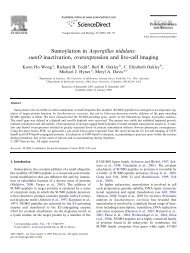Ice nucleation active bacteria and their potential role in precipitation
Ice nucleation active bacteria and their potential role in precipitation
Ice nucleation active bacteria and their potential role in precipitation
You also want an ePaper? Increase the reach of your titles
YUMPU automatically turns print PDFs into web optimized ePapers that Google loves.
ERCA 6 97<br />
proven to be effective under experimental conditions. However, much of this work was oriented around<br />
stra<strong>in</strong>s of <strong>bacteria</strong> that scientists rendered <strong>in</strong><strong>active</strong> as ice nuclei by excis<strong>in</strong>g out the gene cod<strong>in</strong>g for<br />
the ice <strong>nucleation</strong> prote<strong>in</strong>. This opened the heated debate, that still festers today, about the deliberate<br />
release of genetically modified organisms <strong>in</strong>to the environment, <strong>and</strong> frost control products based on<br />
such <strong>bacteria</strong> never saw the light. Furthermore, the cost of this technology would have likely been<br />
prohibitive for farmers [99]. A formulation of a naturally-occurr<strong>in</strong>g non INA bacterium that is effective<br />
<strong>in</strong> controll<strong>in</strong>g frost damage was registered <strong>in</strong> the USA <strong>and</strong> marketed for a few years <strong>in</strong> the early<br />
1990’s [47]. Nevertheless, the image of biological control of frost via antagonistic <strong>bacteria</strong> sprayed<br />
on crops was severely ta<strong>in</strong>ted. This naturally occurr<strong>in</strong>g antagonistic stra<strong>in</strong> is still marketed, but under the<br />
name Blightban A506 R○ to highlight its effectiveness <strong>in</strong> control of a family of <strong>bacteria</strong>l diseases known<br />
as blight [47].<br />
Breed<strong>in</strong>g of plants to obta<strong>in</strong> disease resistance is also prom<strong>in</strong>ent <strong>in</strong> the arsenal of disease control<br />
strategies <strong>and</strong> is a possible means of frost control. Plant breeders select<strong>in</strong>g for frost resistance may<br />
select plant l<strong>in</strong>es with altered physiology or they may <strong>in</strong> fact be select<strong>in</strong>g for plants that <strong>in</strong>hibit<br />
INA <strong>bacteria</strong> from grow<strong>in</strong>g <strong>in</strong> or on the plant [100]. In this case a consistent <strong>in</strong>oculation scheme<br />
employ<strong>in</strong>g appropriate INA <strong>bacteria</strong> should by rights differentiate between these different bases for<br />
frost tolerance or resistance. However there are many complicat<strong>in</strong>g factors <strong>in</strong>clud<strong>in</strong>g the fact that such<br />
<strong>bacteria</strong> can produce antimicrobial compounds <strong>in</strong>hibit<strong>in</strong>g other disease caus<strong>in</strong>g <strong>bacteria</strong> <strong>and</strong> fungi, as<br />
illustrated above for the case of the Blightban A506 R○ <strong>bacteria</strong>l stra<strong>in</strong>. If only we could enjoy the pure<br />
<strong>and</strong> serene science of the subatomic world, or even <strong>in</strong> a test tube, rather than the multidimensional<br />
chess game that we see <strong>in</strong> field biology. Perhaps we should simply note that INA <strong>bacteria</strong> left to<br />
<strong>their</strong> own devises, can cause frost <strong>in</strong>jury where it might otherwise not happen, <strong>and</strong> that few if any<br />
advances have been made <strong>in</strong> control of these <strong>bacteria</strong>. Perhaps we will have more success us<strong>in</strong>g<br />
specific <strong>bacteria</strong> to cause frost <strong>in</strong>jury on undesirable weeds, as an alternative to chemical control.<br />
One caution to breeders might be <strong>in</strong> order: the strong selection aga<strong>in</strong>st phytopathogenic <strong>bacteria</strong> <strong>in</strong><br />
plant variety selection may have an unanticipated consequence <strong>in</strong> reduced production of INA <strong>bacteria</strong><br />
that naturally seed clouds as we will see <strong>in</strong> the next section. In short, one must be careful for what<br />
one desires.<br />
There are a few notable <strong>and</strong> practical applications of the research <strong>in</strong>volv<strong>in</strong>g INA <strong>bacteria</strong> <strong>and</strong> the<br />
<strong>nucleation</strong> prote<strong>in</strong>. The product Snomax R○ , cells of P. syr<strong>in</strong>gae that have been freeze-dried <strong>and</strong> then<br />
killed by gamma radiation, is widely used to seed snowmak<strong>in</strong>g canons at ski resorts [47]. This has led<br />
to significant reductions <strong>in</strong> the energy consumption of snow-mak<strong>in</strong>g. But because of its efficiency, use<br />
of this product has probably also led ski resorts to greatly <strong>in</strong>crease water consumption thereby putt<strong>in</strong>g a<br />
significant dra<strong>in</strong> on local lakes <strong>and</strong> rivers [47]. Use of the ice <strong>nucleation</strong> prote<strong>in</strong> <strong>in</strong> freeze-concentration of<br />
foods <strong>and</strong> <strong>in</strong> textur<strong>in</strong>g prote<strong>in</strong>s is under <strong>in</strong>tense study [94]. These applications are of <strong>in</strong>terest particularly<br />
because the rate of the freez<strong>in</strong>g process <strong>and</strong> the size of the crystals formed, essential to the quality of<br />
the products, can be f<strong>in</strong>ely controlled <strong>in</strong> the presence of high temperature freez<strong>in</strong>g catalysts such as<br />
<strong>bacteria</strong>l ice nuclei. This work also benefits from <strong>bacteria</strong>l stra<strong>in</strong>s that produce cell-free ice nuclei, i.e.<br />
those that are liberated from cells <strong>in</strong> the form of vesicles <strong>and</strong> from the apparent <strong>in</strong>nocuousness of the<br />
<strong>nucleation</strong> prote<strong>in</strong> for humans [94]. One of the well-characterized properties of the ice <strong>nucleation</strong> prote<strong>in</strong><br />
is its N-term<strong>in</strong>al. This end of the ice <strong>nucleation</strong> prote<strong>in</strong> anchors the prote<strong>in</strong> <strong>in</strong>to the outer membrane of<br />
the <strong>bacteria</strong>l cell as described above. The sequence of DNA cod<strong>in</strong>g for this part of the prote<strong>in</strong> has been<br />
comb<strong>in</strong>ed with DNA sequences for a wide range of prote<strong>in</strong>s of practical or fundamental research <strong>in</strong>terest<br />
<strong>and</strong> <strong>in</strong>troduced <strong>in</strong>to the genome of <strong>bacteria</strong> dest<strong>in</strong>ed to translate this DNA <strong>in</strong>to prote<strong>in</strong>. This technique,<br />
called prote<strong>in</strong> display, allows microbiologists to ornate the cells of these <strong>bacteria</strong> with the jewellery (i.e.,<br />
prote<strong>in</strong>s) of <strong>their</strong> choice [94]. This can facilitate the study of prote<strong>in</strong>s that are difficult to produce under<br />
natural conditions such as those associated with viruses pathogenic to humans [101] or can also enhance<br />
the efficiency of enzymes <strong>in</strong>volved <strong>in</strong> bioremediation of polluted sites [102]. The ice <strong>nucleation</strong> prote<strong>in</strong><br />
<strong>and</strong> its associated gene have also been deployed <strong>in</strong> detection of <strong>bacteria</strong> or <strong>in</strong> reporter systems to verify<br />
expression of genes of <strong>in</strong>terest as described by Cochet <strong>and</strong> Widehem [94].









